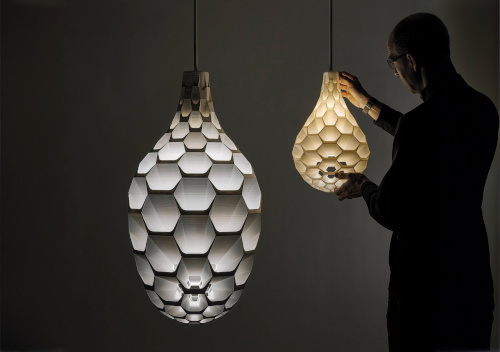A striking 3D-printed pendant light, made from bioplastic, has been acclaimed by design critics.
The creators of the Hedron chandelier say they have drawn inspiration from nature, with hexagonal geometry and renewable bioplastic material.
The shade is an array of tapered cell walls, precisely angled to bounce light twice from the internal LED source to the softly diffused light exiting the luminaire.
The 3D-printed surfaces have a subtle, striated texture creating a distinctive gradient across each surface.
With a translucent white natural colour, the pendant has an ethereal quality by day and a warm quality of light by night. There’s also the option of white ceramic coating which gives the product a more dramatic quality of light, with strong gradients from light to dark across its textured surfaces.
The Hedron is work of the multi-disciplinary design studio Mickus Projects, which specialises in furniture, lighting, architecture and design strategy.
Founded by Ben K. Mickus in 2006 in Brooklyn, New York and now based in the San Francisco Bay Area, the practice takes on design, fabrication and often installation of their work.
The team behind the brand say that it is informed by ‘the exploration of multi-sensory experience, interplay between materials, and craftsmanship enhanced by digital technology’.
The studio’s design process is set up around ‘a Venn diagram of research, collaboration, and experimental design’.
‘We begin each project with a deep investigation into materials and form, and develop designs in collaboration with specialists and local craftsmen.’
3D printed luminaires were once viewed as curios in the lighting industry, but now big name clients such as McDonald’s and Marks & Spencer are specifying them.
The advent of 3D printing technology has empowered designers to create intricate and customised luminaires that not only illuminate spaces but also serve as unique pieces of art.
One of the key advantages of 3D printing in luminaire production is the unparalleled flexibility it offers in terms of design. Traditional manufacturing methods often impose limitations on intricate and complex designs, but 3D printing allows for the creation of highly detailed and intricate structures that were once deemed impossible.
This capability enables designers to experiment with innovative shapes, patterns, and textures, resulting in luminaires that push the boundaries of conventional aesthetics.
Crucially, 3D printed luminaires often showcase enhanced sustainability. The additive manufacturing process used in 3D printing minimises material waste and the ability to use eco-friendly and recycled materials further contributes to their sustainability.
• Learn more about sustainable lighting at Circular Lighting Live 2025, Recolight’s flagship conference and exhibition, which takes place on Thursday 25 September 2025 at the Minster Building in the City of London. Free to specifiers, Circular Lighting Live 2025 will feature leading experts, specifiers and policy makers who will share their insights into forthcoming standards and legislation, emerging technologies and new business models. More info: www.circularlighting.live

